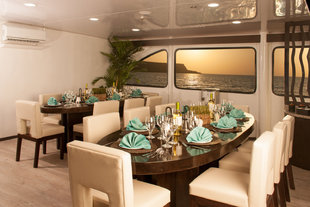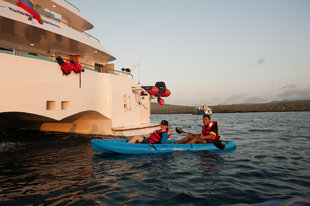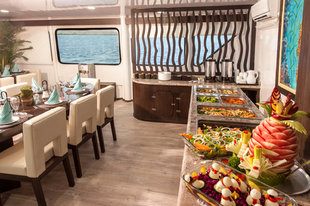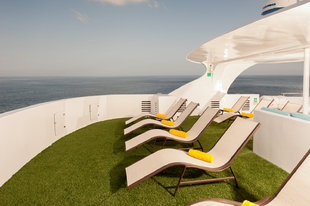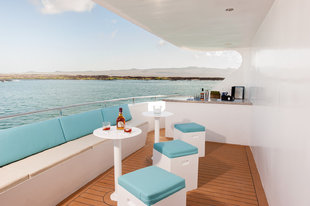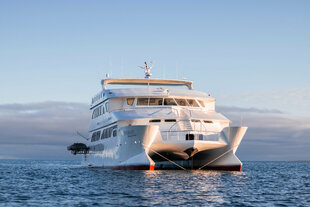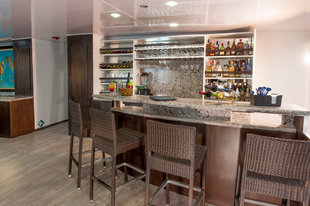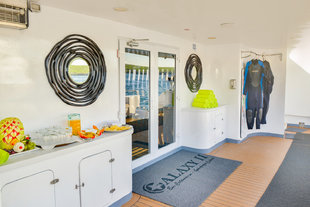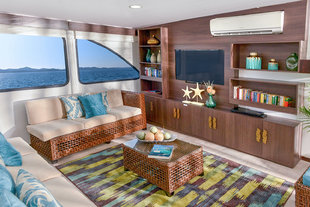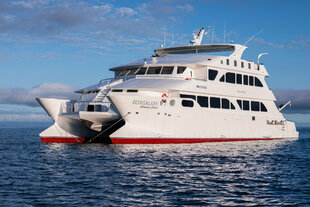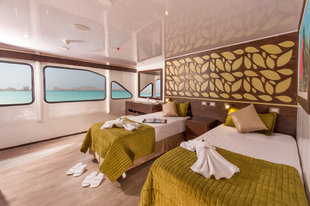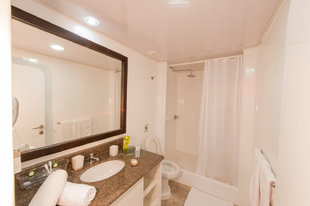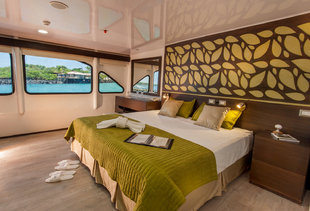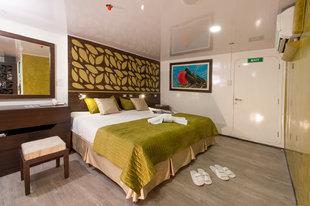Eco Galaxy is a comfortable motor catamaran which was designed to offer fuel efficiency at the same time as a high-quality onboard experience. With a maximum capacity of 16 passengers, all 8 ensuite cabins are spacious, with common outdoor space on two aft decks and a wide-open top deck.
Four cabins are situated on the Main Deck and the other four on the Upper Deck. Beds can be configured as twins or doubles. Those cabins on the Upper Deck can be connected to make two-bedroom suites – ideal for a family.
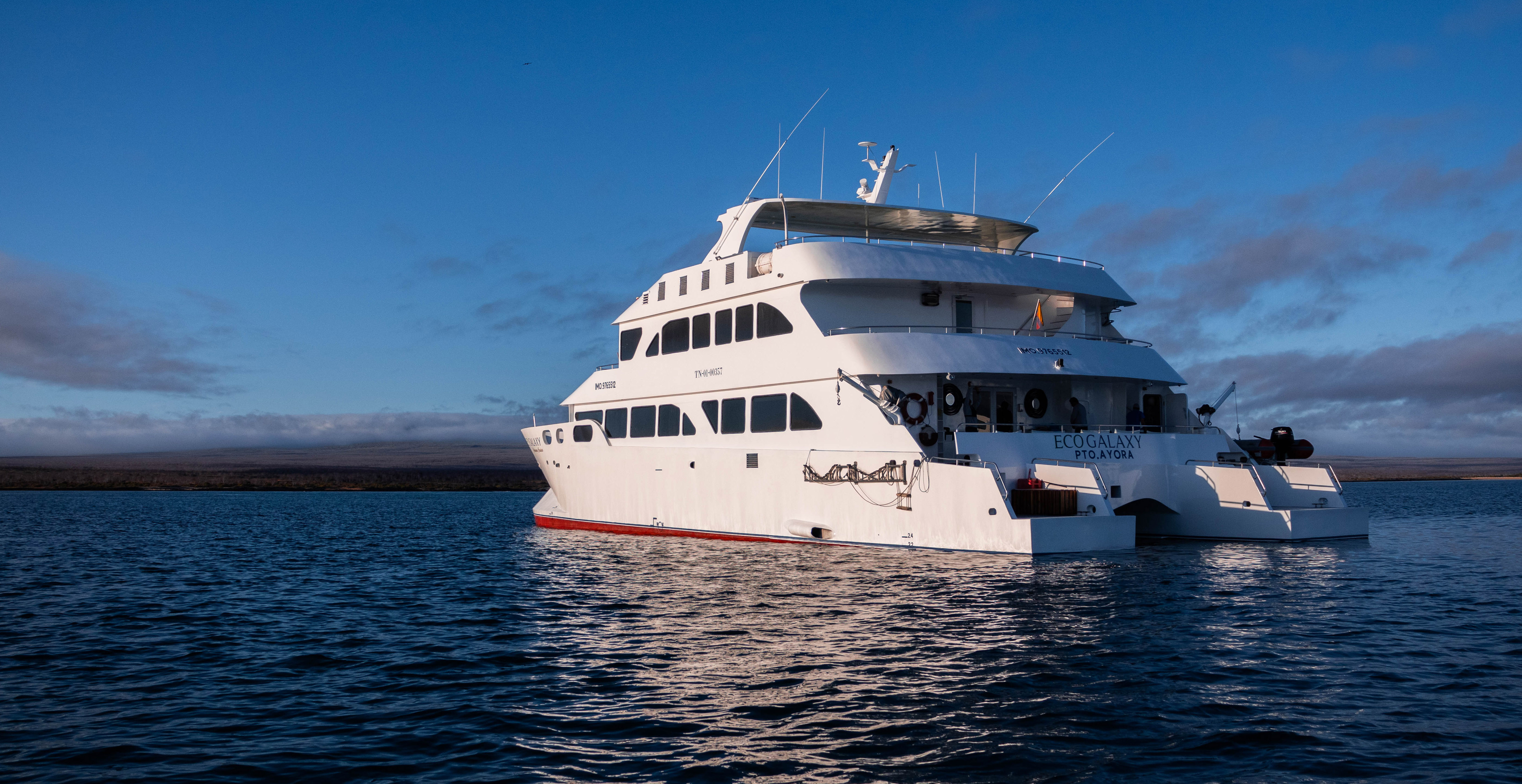
Inside the Main Deck, there is a spacious dining, bar, library and living area; at the other end of which there is a boutique briefing area. Great attention is given to onboard service, good food, helpful guides and a professional crew.
Itineraries have been designed to combine island hiking, as well as extensive snorkelling and the option for some kayaking.
Private facilities in each cabin: private bathrooms, cold/hot water; air conditioned, hair dryer, telephone for internal communication on board, safe box, and high speaker.
Wildlife & Photography
The main focus of this trip is to experience the Galapagos’ unique wildlife and landscapes above, on and below the water. All itineraries include activities like hiking, kayaking, snorkelling, panga rides and swimming on excursions which take place twice daily, helping to give you the opportunity to explore the archipelago from different perspectives.
Each of the islands provides its own individual environment due to their age differences and stages of colonisation, which can differ by millions of years. As you make your way through any of the itineraries here, you will notice gradual changes in the landscapes and wildlife which you are surrounded by. Some of the wildlife which you can hope to see here includes Galapagos Sea Lions, Marine and Land Iguanas, Nazca and Blue-Footed Boobies, Galapagos Tortoises, Galapagos Penguins and Flightless Cormorants, among many others.
The great abundance and variety of life here makes this trip ideal for photographers. There are plenty of opportunities for every photographer to get their shots – macros of sunbathing Marine Iguanas, wide-angles of Sea Lion colonies and the islands and underwater captures of Sharks and Rays are just some of the possibilities here.
Even though the trips offered here explore a lot of the archipelago’s wonders, there are many other ways which you can explore the Galapagos Islands. If you wanted to extend your stay here to experience more of this location, you could book an add-on experience, such as a dive liveaboard from our Galapagos Dive Liveaboards page or one from our Galapagos page. We also offer trips in mainland Ecuador which you could choose to experience too.
Technical Specifications
| Type | First class motor catamaran |
| Construction | Guayaquil 2014 |
| Length | 27 m |
| Beam | 10.5 m |
| Draft | 1.15 m |
| Guest capacity | 16 |
| Crew | 9 + 1 bilingual guide |
| Cruising speed | 10-11 knots |
| Engines | 2x Cummins marine 350 |
| Water capacity | 2,500 gallons |
| Electricity | 110V & 220V |
Deck Plan
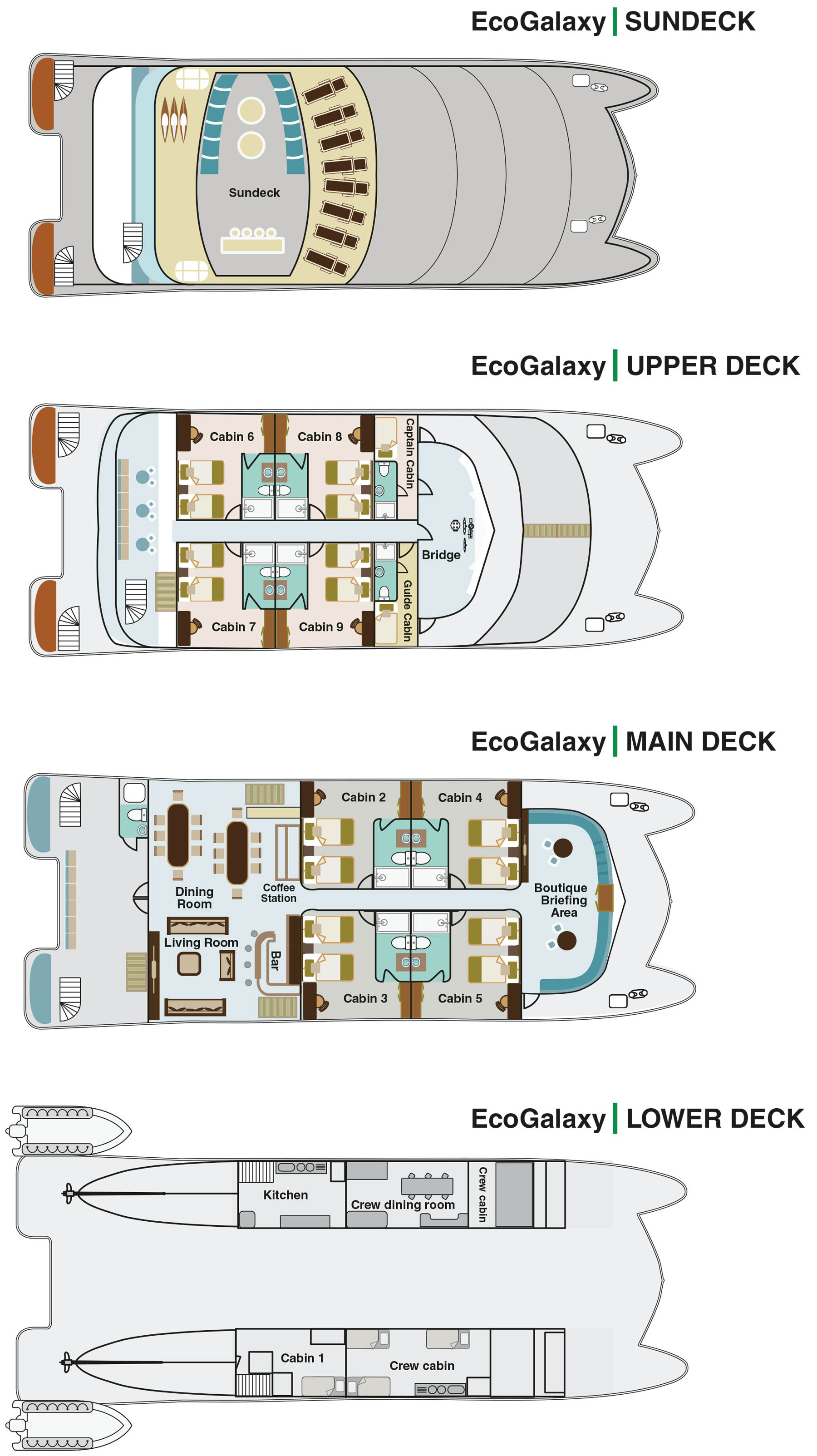
Itinerary
Each itinerary is designed as just a single part of your Galapagos experience and are combinable. We recommend combining itineraries for a more comprehensive visit to the Galapagos Islands.
Please note that these itineraries are subject to change without notice due to seasonal changes, last minute weather conditions and the decision of the Galapagos National Park authority.
Itinerary A – East (5 days / 4 nights)
Runs until 31st March 2026
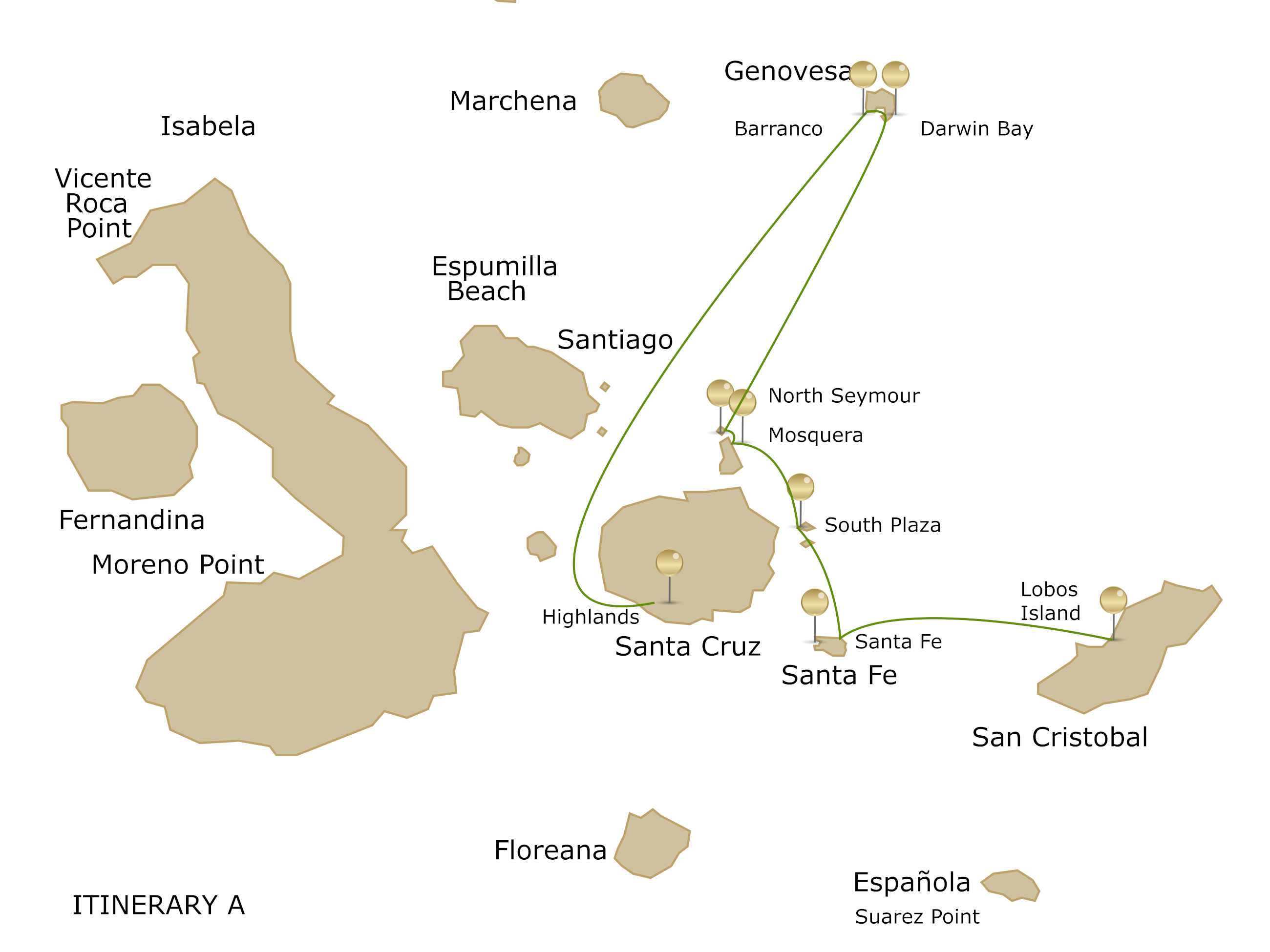
Day 1 (Tuesday) – Arrival & Lobos Island
AM: Arrival, San Cristobal Island
Land at San Cristobal airport where you will be directed towards the airport terminal building. You will need to queue here to pay your Galapagos National Park fee and have your luggage inspected for potential contaminants to the island, such as plant matter or seeds.
Please wait for you baggage to be unloaded. Collect it and then look for someone holding a card with your name or the name of your Galapagos yacht: Eco Galaxy.
PM: Lobos Island, San Cristobal Island
The beach on Lobos Island harbours a colony of Galapagos sea lions. As in other colonies in the archipelago, you can approach nurturing females within a few metres. In the breeding season this colony is also visited by territorial males, defending and mating the harem on their section of beach. This low islet is home to more than just Galapagos sea lions. Two other emblematic species breed here: male blue-footed boobies and great frigate birds. In season, booby males try to impress females with clumsy dances, showing off how blue (and healthy) their feet are. Male frigatebirds inflate and wobble huge red throat poaches called gulas. Young fluffy offspring cry for food, whilst juveniles try out their wings ready to fly.
Day 2 (Wednesday) – Santa Fé & South Plaza
AM: Santa Fé Island
Located in the southeastern part of the Galapagos, this island was formed from an uplift rather than being from a volcanic origin, which is why it is mostly flat. There are some theories claiming that this could be the oldest island in the archipelago. Santa Fé is home to a number of endemic species like the Galapagos Hawk, Galapagos snake, Galapagos mockingbird, rice rats and one of the two species of land iguanas on the islands. After disembarking into the beautiful and clear waters, you will be in contact with one of the many sea lion colonies. Along the trail, many saltbushes can be seen, as well some particularly impressive giant Opuntia cacti ‘trees’.
The island is some 24 km2 in area and a maximum 60 metres above sea level. The waters which surround it can be a lovely turquoise blue, with a protective barrier of rocks creating a semi-lagoon which is ideal for humans and sealions alike for swimming and snorkelling.
You will be landing at a bay on Santa Fé, surrounded by Giant Prickly-Pear Cacti. In this bay is a Galapagos Sea Lion colony. Further inland are Santa Fé Iguanas and Galapagos Hawks can be seen. The bay is home to a great trail for spotting wildlife like Finches, Galapagos Doves, Mockingbirds and Lava Lizards. Afterwards, you will be able to snorkel in the waters of the bay with chances of seeing Reef Sharks and Sea Lions as well as Tropical Fish.
PM: South Plaza Island
South Plaza is a beautiful island formed out of lava which bubbled up to the sea surface. It is relatively small but very diverse in its botany and very good for spotting Land Iguanas. hybrid Iguanas exist here, created through the mating of male marine iguanas and female land iguanas.
There are approximately 1,000 Galapagos Sealions on the island and birdlife is plentiful. Cliffs on the western side are nesting sites for Blue-footed and Nazca Boobies, whilst we can find Darwin's Finches amongst the rocks of the eastern side, Lava Gulls and lovely Swallow-tail Gulls. Red-billed Tropicbirds often swoop low overhead, whilst in the sea beneath the western cliffs we can often see schools of fish close to the surface.
This island can be one of the best for photography.
Day 3 (Thursday) – North Seymour & Mosquera
AM: North Seymour Island
This islet is one of most visited sites in the Galapagos and it is teeming with birdlife. An easy circular path takes you through the archipelago’s most extensive colonies of blue-footed boobies and frigate birds. At the beginning of the breeding season, adult frigatebird-males blow up their vivid red pouches (gulas) to impressive football-sized balloons. This is one of the few spots where you can compare the magnificent and the great frigatebird breeding next to each other.
You are likely to come across several land iguanas on North Seymour and the coast can be a good place to spot Galapagos sealions.
PM: Mosquera Island
Mosquera is a low white sand island which lies in the Itabaca Channel between Baltra Island (South Seymour) and North Seymour. It is surrounded by coral reefs, providing protected conditions for snorkelling and scuba diving. Above water, it has a large sealion colony and is good for spotting birds like America oyster catchers, blue-footed boobies and lava gulls.
Day 4 (Friday) – Darwin Bay & Prince Philip’s Steps
AM: Darwin Bay, Genovesa Island
Inside the submerged caldera of Genovesa lies Darwin Bay, whose diameter is more than 1.5km (1 mile) and it is almost 200 m (650 ft) deep. The small area will surprise you repeatedly, walking along a coral sand beach, crossing barren lava formations and creeks, passing tidal pools, shrubs and further ahead following the top of some cliffs. With this peaceful surrounding, every species has occupied its own ecological niche (or habitat) without disturbing others. There is great birdlife here with starring species including Red-Footed Boobies, Great Frigatebirds & Laval Gulls. These often share the beach with Galapagos Sea Lions.
PM: El Barranco, Genovesa Island
You will have to hike and overcome the steep stairs from the landing dock to a bush of palo santo shrubs on top. Red-footed boobies gratefully use these scarce nesting places so that they don’t have to nest on the rocky ground. Upon arriving at the edge of the rim, the bushes open up and you can enjoy panoramic views, a sea breeze and the amazing flying skills of countless seabirds. Following the exposed rim, you will first pass a place where we usually encounter a colony of Nazca boobies; and finally reach the extensive storm petrel nesting places. If you are lucky, you can spot the well camouflaged short-eared owl hunting for them on foot!
Day 5 (Saturday) – Santa Cruz Highlands & Departure
AM: Highlands, Santa Cruz Island
The road to the highlands leaves from Bellavista, a small village located a 15-minute drive from Santa Cruz’ main town of Puerto Ayora. The road passes through the Galapagos’ most productive agricultural zone, up to the National Park boundary. We find Miconia vegetation at this altitude, changing to the Fern and Sedge zone as we ascend further. With clear weather, we can enjoy beautiful scenes of rolling hills and extinct volcanic cones covered with grass and lush greenery all year round. You will see Galapagos Giant Tortoises, many species of highland birds rare in the lowlands and will enter an old lava tunnel here.
PM: Departure, Baltra Island
Your guide & some crew members will go with you to Baltra where you will board the airport shuttle. Your guide will remain with you through the check-in counters & departure hall.
Itinerary B – West (6 days / 5 nights)
Runs until 31st March 2026
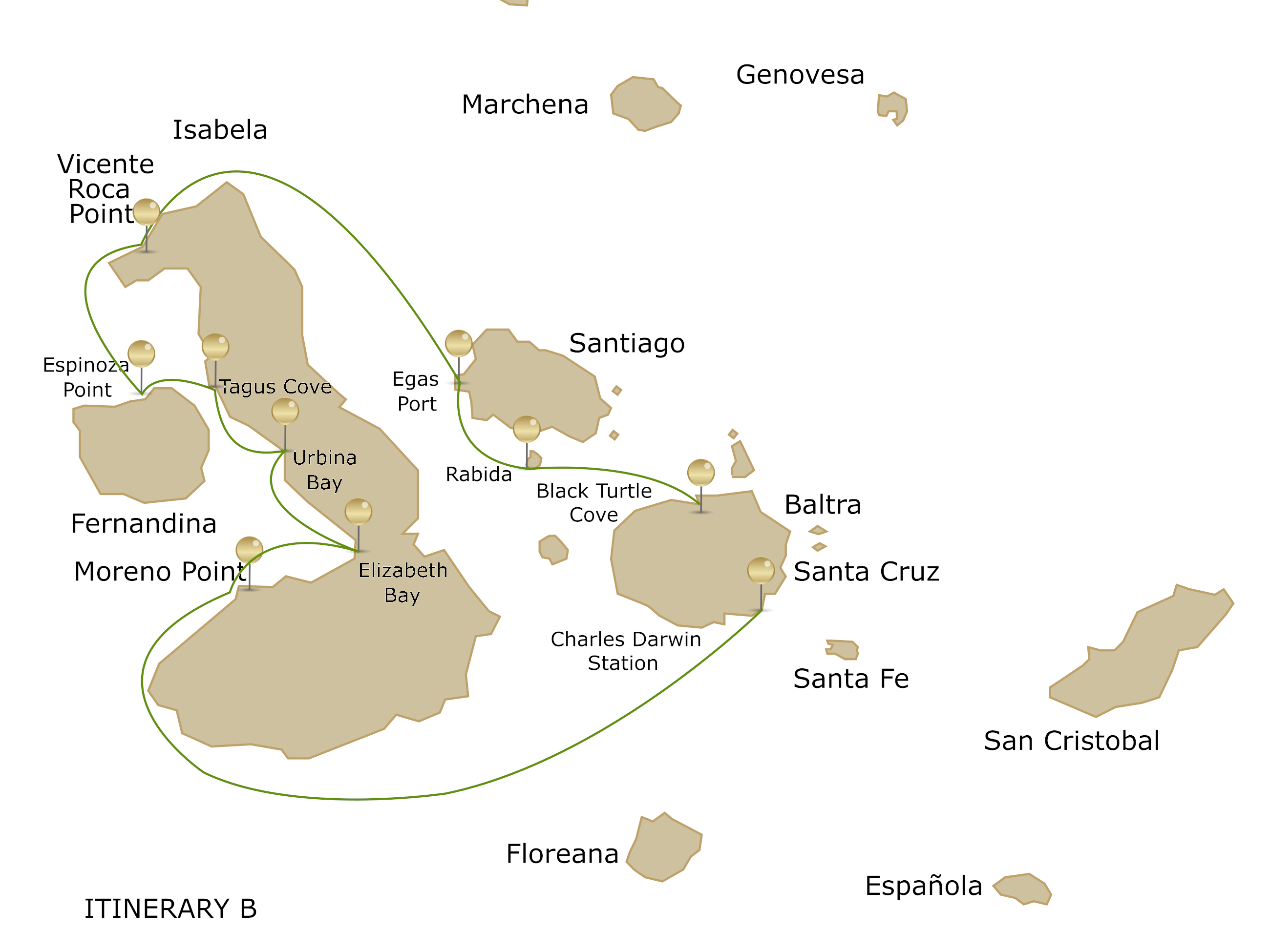
Day 1 (Saturday) – Arrival & Charles Darwin Centre
AM: Arrival, Baltra Island
Upon arrival Baltra, travellers pass through an airport inspection point to make sure that no foreign plants or animals are introduced to the islands, and to pay the park entrance fee of $200 (unless it has been prepaid). A guide will meet you, help you collect your luggage and escort you on a short bus ride to the harbour.
PM: Charles Darwin Research Station, Santa Cruz Island
Although the great majority of Galapagos visitors come here to observe and appreciate natural wonders, it is also interesting to learn how the protection and conservation of the islands are carried out. The main attractions are the National Park information centre, the Van Staelen Exhibition Hall, the Breeding and Rearing Centre for young tortoises, and adult Galapagos tortoises in captivity.
Day 2 (Sunday) – Moreno Point & Elizabeth Bay
AM: Punta Moreno, Isabela Island
Punta Moreno is the site of a large dry lava field created by Cero Azul Volcano. This is a strange landscape, with vegetation-less lava, tidal lagoons and mangroves all in the same space. In some of the large tidal lagoons and pools, you may be able to see Green Turtles and Sharks. The mangrove forests provide habitat for other animals like Galapagos Flamingos, Brown Pelicans and some Galapagos Penguins.
PM: Elizabeth Bay, Isabela Island
This is a marine visitor site, so the excursion has no landing point. Your panga ride starts with a visit to the Marielas islets: home to the largest and most important penguin colony in the Galapagos Islands. The excursion continues into a cove, surrounded by red mangroves, where you can admire their red roots and green leaves. Here, you might be able to observe sea turtles, flightless cormorants, spotted eagle rays, golden cownose rays, brown pelicans and sealions. You might also see Galapagos hawks soaring overhead with schools of pompano and dorado fish swimming down below.
Day 3 (Monday) – Urbina Bay & Tagus Cove
AM: Urbina Bay, Isabela Island
Urbina Bay is on the west coast of Isabela and has a recently uplifted seabed which has forced corals up above the water’s surface, providing a unique snorkelling experience. There are 2 treks at this bay which offer chances of seeing Galapagos Tortoises & large Land Iguanas amongst other wildlife including Flycatchers, Finches & Mockingbirds.
PM: Tagus Cove, Isabela Island
A tour along the cliffs will give visitors a good chance to see the Galapagos penguin, the flightless cormorant and other seabirds. From the landing dock, it is about a 30-minute hike along the trail up to the top of the cliff from where you can view Darwin Lake, an uplifted lake saltier than the sea. You can also see several volcanoes from this location. Look carefully at the graffiti on the surrounding cliffs of the cove, done by pirates, whalers and buccaneers in past centuries!
There is a trail through palo santo forest for good bird sightings and a boat trip around the shore for the chance to see Galapagos Penguins, Flightless Cormorants, Marine Iguanas and the Galapagos Martin.
Day 4 (Tuesday) – Espinosa Point & Vicente Roca Point
AM: Punta Espinoza, Fernandina Island
Fernandina is the third largest island in the archipelago and has a single visitor site: Punta Espinoza, located at the northeastern tip of the island. Here, marine iguanas conglomerate in larger groups than on any other island. They bask around in the sand, swim near the shore and sometimes block the way at the landing dock. Among the unique species found here is the flightless cormorant.
PM: Punta Vicente Roca, Isabela Island
There are great snorkelling opportunities at Vicente Roca Point thanks to upwelling cold-water currents here. Marine life you may encounter in the area as you snorkel near some of the tallest cliffs in the Galapagos includes various Shark species, Galapagos Penguins, Seahorses & Mola-Mola. Other animals which you can hope to see here are Nazca & Blue-Footed Boobies, Brown Pelicans & Flightless Cormorants.
Day 5 (Wednesday) – Egas Port & Rábida
AM: Puerto Egas, Santiago Island
Puerto Egas is a black beach located at the west side of Santiago Island. Volcanic tuff deposits formed this special black sand beach and made it the main attraction of the Island. This site is called Puerto Egas because Hector Egas attempted to exploit the salt, which failed because the price of salt on mainland South America was too low to make it a viable export. It is possible to see many shorebirds here as you walk along the port’s trail, such as Herons and Oystercatchers. At the end of the trail of a small Galapagos Fur Seal colony. As well as walking opportunities, you can snorkel here and see a diverse range of Fish, Turtles and Reef Sharks.
PM: Rábida Island
Rábida Island is unique because of the red colour of the rocks and sand. The volcanic material on this island is very porous and external factors such as rain, saltwater and sea breeze have acted as an oxidising agent. A short walk along a trail leads us to a coastal lagoon behind the beach where we can see land birds including finches, doves, yellow warblers and mockingbirds; seabirds such as pelicans, masked and blue-footed boobies; and of non-feathered species you can hope to see marine iguanas and sealions. Our team will take you to a small brackish lagoon where you can anticipate a colony of flamingos. Snorkelling at the beach often gives great encounters with Fish, Sea Lions and Reef Sharks.
Day 6 (Thursday) – Black Turtle Cove & Departure
AM: Black Turtle Cove, Santa Cruz Island
Black Turtle Cove offers engineless activities, so you will explore it by dinghy, paddling across the mangrove forested coastline of this stretch of Santa Cruz. There is great wildlife here due to the high levels of protection of this environment such as Sea Turtles, Pelicans & Sharks.
PM: Departure, Baltra Island
Your guide & some crew members will go with you to Baltra where you will board the airport shuttle. Your guide will remain with you through the check-in counters & departure hall.
Itinerary C – Southeast (6 days / 5 nights)
Runs until 31st March 2026
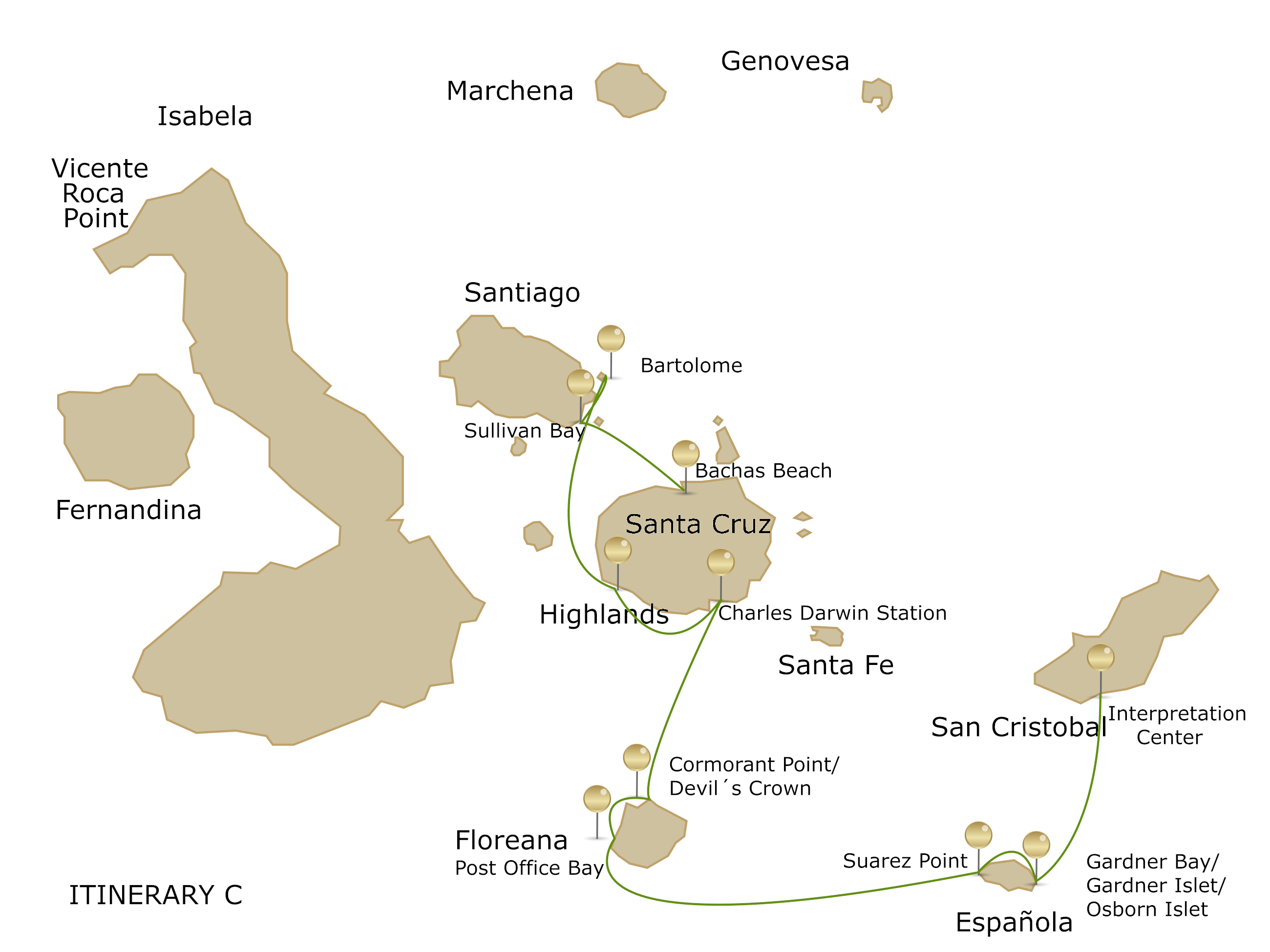
Day 1 (Thursday) – Arrival & Bachas Beach
AM: Arrival, Baltra Island
Upon arrival Baltra, travellers pass through an airport inspection point to make sure that no foreign plants or animals are introduced to the islands, and to pay the park entrance fee of $200 (unless it has been prepaid). A guide will meet you, help you collect your luggage and escort you on a short bus ride to the harbour.
PM: Playa las Bachas, Santa Cruz Island
These two small beaches are found to the west of Turtle Cove. Their sand is made of decomposed coral, which makes it white and soft, and a favourite nesting site for sea turtles. Behind one of the beaches there is a small brackish water lagoon, where it is occasionally possible to observe flamingos and other coastal birds, such as black-necked stilts and whimbrels.
The other beach is longer, but it has two old barges that were abandoned during World War II, when USA used Baltra Island as a strategic point from which to protect the Panama Channel. The rocky shoreline can be a great place to photography Sally Lightfoot Crabs.
Snorkelling on the beach, you will be able to see many common Galapagos Fish species as well as White-Tip Reef Sharks and Rays.
Day 2 (Friday) – Sullivan Bay & Bartolomé
AM: Sullivan Bay, Santiago Island
Setting foot at the lava stream covering Sullivan Bay is like landing on the moon. The desolate, stretched out lava fields seem mostly lifeless, but there is plenty to see on this highly popular site, with lots to photograph. Pacific green turtles seasonally bury eggs in the tiny white sand beach, where you might also encounter crabs, a stray blue heron or an American oystercatcher. On the lava flows sparse pioneer vegetation such as lava cacti and carpetweed are able to grow. You might also encounter a lava lizard, locusts or a small species of snake called the Galapagos racer. Snorkelling here may offer opportunities to see Galapagos Penguins.
PM: Bartolomé Island
One of the Galapagos’ most iconic locations, the beautiful volcanic islet of Bartolomé is among the youngest islands in the archipelago. On a geological scale Bartolomé was only recently born out of volcanic activity. Although at first sight lifeless, Bartolomé offers some of the wildest landscapes and best panoramas of the entire archipelago. To enjoy the postcard view of the idyllic Pinnacle Bay, you have to climb steps to a viewpoint on top of the island (114m / 375ft). Enter a dramatic world of threatening (though extinguished) nearby spatter cones, craters, and lightweight lava droplets that have been spewed out by fiery fountains. The Summit Trail is also ideal for witnessing how scanty pioneer vegetation such as lava cacti manage to take root on the bare virgin lava fields. There is also snorkelling here with clear and calm waters, Galapagos Penguins and colourful marine life.
Day 3 (Saturday) – Santa Cruz Highlands & Charles Darwin Station
AM: Highlands, Santa Cruz Island
The road to the highlands leaves from Bellavista, a small village located a 15-minute drive from Santa Cruz’ main town of Puerto Ayora. The road passes through the Galapagos’ most productive agricultural zone, up to the National Park boundary. We find Miconia vegetation at this altitude, changing to the Fern and Sedge zone as we ascend further. With clear weather, we can enjoy beautiful scenes of rolling hills and extinct volcanic cones covered with grass and lush greenery all year round. Here you will visit the ponds of Giant Galapagos Tortoise, see highland bird species and visit an old lava tunnel.
PM: Charles Darwin Research Station, Santa Cruz Island
Although the great majority of Galapagos visitors come here to observe and appreciate natural wonders, it is also interesting to learn how the protection and conservation of the islands are carried out. The main attractions are the National Park information centre, the Van Staelen Exhibition Hall, the Breeding and Rearing Centre for young tortoises, and adult Galapagos tortoises in captivity.
Day 4 (Sunday) – Cormorant Point / Devil’s Crown & Post Office Bay
AM: Punta Cormorant & Devil’s Crown, Floreana Island
The peninsula of Cormorant Point marks the extreme northern cape of Floreana – an island formed from smaller volcanic cones, covered now by tropical dry forest (palo santo). At the landing beach, you are likely to be welcomed by a small colony of Galapagos sealions. The green sand on this beach contains a high percentage of glassy olivine crystals which have been blown out by the surrounding tuff cones.
The ‘flour sand’ beach on the southern side of the peninsula is made up of white coral ground into sand by Parrotfish. It feels very smooth on the feet. You may be able to spot stingrays who use the sandy bottom to bury themselves. During the first months of the year, Pacific green turtles come ashore to dig a nest in which to bury their eggs.
Devil’s Crown is a small outcrop of rocks off the coast of Floreana near Cormorant Point with a circular arrangement which gives them their name. Here, there is spectacular snorkelling with an abundance of reef fish such as Parrotfish, Surgeonfish & King Angelfish as well as Sharks, Manta Rays & Hammerhead Sharks.
PM: Post Office Bay, Floreana Island
Post Office Bay is primarily of cultural significance. In times before there was a reliable postal service, a barrel onshore was a point where British 16th century whalers and poachers could post a letter. You are encouraged to write and address one or two post cards; whilst at the same time picking out any which are addressed close to your home, which you are happy to hand deliver when you return.
Shallow waters offshore are lovely to swim in. If you doon a mask and snorkel, you might see Pacific green turtles which often graze here.
Day 5 (Monday) – Suarez Point & Gardner Bay
AM: Punta Suarez, Española Island
Huge ocean waves crash onto the southern basaltic cliffs of Suarez Point, forming a spectacular blowhole. where the water sprays metres high into the air (depending on the season, the tide and how strongly the sea breeze pushes the waves). Wildlife is in abundance here, with Sea Lions, Marine Iguanas, Nazca and Blue-Footed Boobies and an Albatross Colony (present from April to January) all visible by panga.
PM: Gardner Bay & Gardner Islet & Osborn Islet, Española Island
The striking white beach at Gardner Bay is an important breeding site for Pacific green turtles. However, without doubt its main attraction is the Galapagos sea lion colony. Females stay year-round in this nursery, suckling their pups up to an age of 3 years, although they start to fish after 5 months of their birth. During the breeding and mating season, the colony becomes even bigger. As well as walking along the beach, you will be able to snorkel in the bay with Sea Lions, Reef Sharks, Rays and an array of fish species like Angelfish, Parrotfish, Damselfish and Surgeonfish.
Gardner Islet is just off the coast of Española and is a great snorkelling site for a wide range of marine life. Some of the main creatures you can hope to see as you snorkel or kayak here include Galapagos Sea Lions, Eels, Pufferfish and Starfish.
Osborn Islet is just southeast of Gardner Bay where a similar snorkelling quality to Gardner Islet can be expected. You will be able to see Parrotfish, Sea Lions, Butterfly Fish and more.
Day 6 (Tuesday) – Interpretation Centre & Departure
AM: Interpretation Centre, San Cristobal Island
The San Cristóbal Interpretation Centre just outside the provincial capital of Puerto Baquerizo Moreno, is a perfect complement to the field explanations and briefings of your naturalist guide and host. Information panels are in English and Spanish, with many photographs, models and true to life dioramas which tell the background story of the islands in different ways. They really capture what makes the Galapagos Islands so unique. The well-maintained botanical garden with native species from the arid zone (including the giant prickly pear and candelabra cacti) is worth your visit as well; and you will probably spot the Chatham Mockingbird which is endemic to this island - a bird which put Darwin on track to his theory of evolution. The attractive exhibition is quite complete and explains a series of natural circumstances that create the Galapagos’ unique environment: such as the volcanic genesis of the islands, their remoteness from the continent, its ocean currents, its special climate, the arrival of different species, and their establishment, among others. It also recounts historic discovery and attempts of colonisation; and shows a diorama with ancient mail barrels from Post Office Bay.
PM: Departure, San Cristobal Island
Your guide and some crew members will accompany you back to San Cristobal where you will take the airport shuttle. Your guide will remain with you through check-in counters & the departure hall.
Itinerary A – Southeast (5 days / 4 nights)
Runs from 1st April 2026
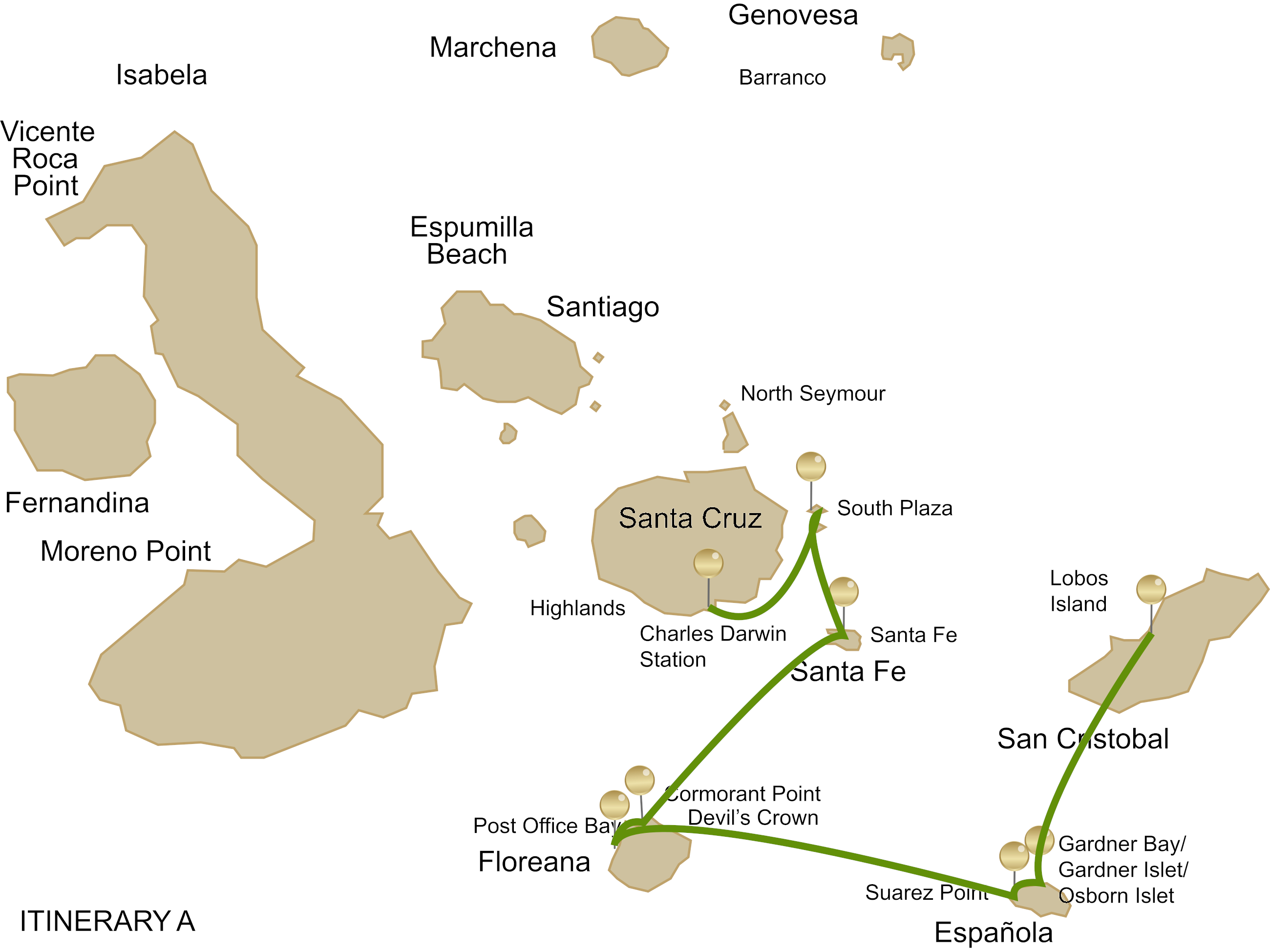
Day 1 (Tuesday)
AM: Arrival, San Cristobal Island
Land at San Cristobal airport where you will be directed towards the airport terminal building. You will need to queue here to pay your Galapagos National Park fee and have your luggage inspected for potential contaminants to the island, such as plant matter or seeds.
Please wait for you baggage to be unloaded. Collect it and then look for someone holding a card with your name or the name of your Galapagos yacht: Eco Galaxy.
PM: Isla Lobos, San Cristobal Island
The beach on Lobos Island harbours a colony of Galapagos sea lions. As in other colonies in the archipelago, you can approach nurturing females within a few metres. In the breeding season this colony is also visited by territorial males, defending and mating the harem on their section of beach. This low islet is home to more than just Galapagos sea lions. Two other emblematic species breed here: male blue-footed boobies and great frigate birds. In season, booby males try to impress females with clumsy dances, showing off how blue (and healthy) their feet are. Male frigatebirds inflate and wobble huge red throat poaches called gulas. Young fluffy offspring cry for food, whilst juveniles try out their wings ready to fly.
Day 2 (Wednesday)
AM: Gardner Bay, Gardner Islet & Osborn Islet, Española Island
The striking white beach at Gardner Bay is an important breeding site for Pacific green turtles. However, without doubt its main attraction is the Galapagos sea lion colony. Females stay year-round in this nursery, suckling their pups up to an age of 3 years, although they start to fish after 5 months of their birth. During the breeding and mating season, the colony becomes even bigger.
Gardner Islet is just off the coast of Española and is a great snorkelling site for a wide range of marine life. Some of the main creatures you can hope to see as you snorkel or kayak here include Galapagos Sea Lions, Eels, Pufferfish and Starfish.
Osborn Islet is just southeast of Gardner Bay where a similar snorkelling quality to Gardner Islet can be expected. You will be able to see Parrotfish, Sea Lions, Butterfly Fish and more.
PM: Punta Suarez, Española Island
Huge ocean waves crash onto the southern basaltic cliffs of Suarez Point, forming a spectacular blowhole. Where the water sprays metres high into the air (depending on the season, the tide and how strongly the sea breeze pushes the waves). This location is home to the only breeding colony of Waved Albatross in the Galapagos. You can also see wildlife such as marine iguanas, Nazca and Blue-Footed Boobies. Take your time for a meditative break in silence at this emblematic viewpoint and convert this unforgettable moment in a lifetime experience.
Day 3 (Thursday)
AM: Post Office Bay, Floreana Island
Post Office Bay is primarily of cultural significance. In times before there was a reliable postal service, a barrel onshore was a point where British 16th century whalers and poachers could post a letter. You are encouraged to write and address one or two post cards; whilst at the same time picking out any which are addressed close to your home, which you are happy to hand deliver when you return.
PM: Punta Cormorant & Devil’s Crown, Floreana Island
The peninsula of Punta Cormorant (Cormorant Point) marks the extreme northern cape of Floreana – an island formed from smaller volcanic cones, covered now by tropical dry forest (palo santo). At the landing beach, you are likely to be welcomed by a small colony of Galapagos sealions. The green sand on this beach contains a high percentage of glassy olivine crystals which have been blown out by the surrounding tuff cones.
The ‘flour sand’ beach on the southern side of the peninsula is made up of white coral ground into sand by Parrotfish. It feels very smooth on the feet. You may be able to spot stingrays who use the sandy bottom to bury themselves. During the first months of the year, Pacific green turtles come ashore to dig a nest in which to bury their eggs.
Devil’s Crown is a small outcrop of rocks off the coast of Floreana near Cormorant Point with a circular arrangement which gives them their name. Here, there is spectacular snorkelling with an abundance of reef fish such as Parrotfish, Surgeonfish & King Angelfish as well as Sharks, Manta Rays & Hammerhead Sharks.
Day 4 (Friday)
AM: Santa Fé Island
Located in the southeastern part of the Galapagos, this island was formed from an uplift rather than being from a volcanic origin, which is why it is mostly flat. There are some theories claiming that this could be the oldest island in the archipelago. Santa Fé is home to a number of endemic species like the Galapagos Hawk, Galapagos snake, Galapagos mockingbird, rice rats and one of the two species of land iguanas on the islands. After disembarking into the beautiful and clear waters, you will be in contact with one of the many sea lion colonies. Along the trail, many saltbushes can be seen, as well some particularly impressive giant Opuntia cacti ‘trees’.
The island is some 24 km2 in area and a maximum 60 metres above sea level. The waters which surround it can be a lovely turquoise blue, with a protective barrier of rocks creating a semi-lagoon which is ideal for humans and sealions alike for swimming and snorkelling.
PM: South Plaza Island
South Plaza is a beautiful island formed out of lava which bubbled up to the sea surface. It is relatively small but very diverse in its botany and very good for spotting Land Iguanas. hybrid Iguanas exist here, created through the mating of male marine iguanas and female land iguanas.
There are approximately 1,000 Galapagos Sealions on the island and birdlife is plentiful. Cliffs on the western side are nesting sites for Blue-footed and Nazca Boobies, whilst we can find Darwin's Finches amongst the rocks of the eastern side, Lava Gulls and lovely Swallow-tail Gulls. Red-billed Tropicbirds often swoop low overhead, whilst in the sea beneath the western cliffs we can often see schools of fish close to the surface.
This island can be one of the best for photography.
Day 5 (Saturday)
AM: Charles Darwin Station, Santa Cruz Island
Although the great majority of Galapagos visitors come to the Charles Darwin Research Station to observe and appreciate natural wonders, it is also interesting to learn how the protection and conservation of the islands are carried out. The main attractions are the National Park information centre, the Van Staelen Exhibition Hall, the Breeding and Rearing Centre for young tortoises, and adult Galapagos tortoises in captivity.
PM: Departure, Baltra Island
Your guide & some crew members will go with you to Baltra where you will board the airport shuttle. Your guide will remain with you through the check-in counters & departure hall.
Itinerary B – West (6 days / 5 nights)
Runs from 1st April 2026
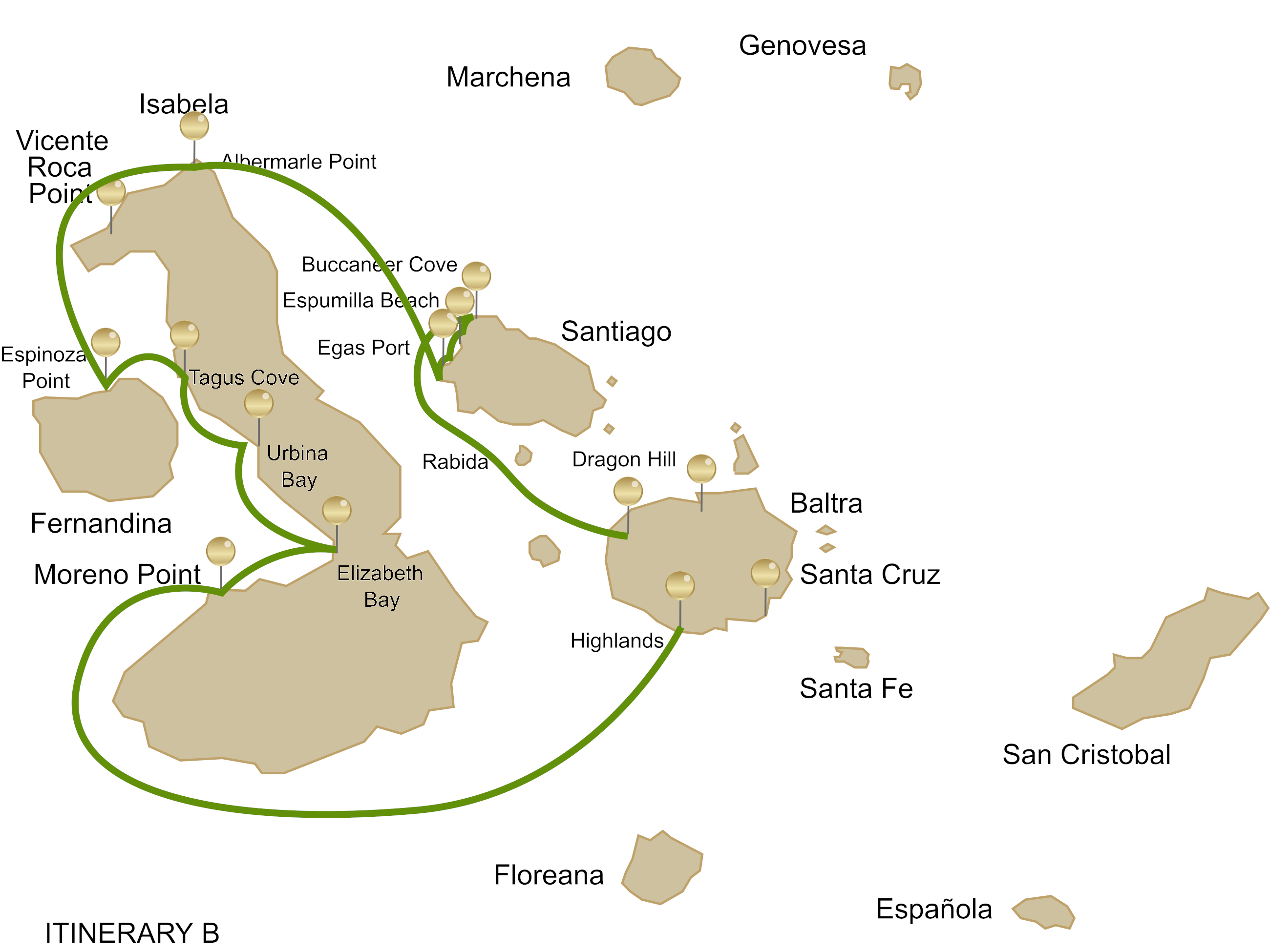
Day 1 (Saturday)
AM: Arrival, Baltra Island
Upon arrival Baltra, travellers pass through an airport inspection point to make sure that no foreign plants or animals are introduced to the islands, and to pay the park entrance fee of $200 (unless it has been prepaid). A guide will meet you, help you collect your luggage and escort you on a short bus ride to the harbour.
PM: Highlands, Santa Cruz Island
The road to the highlands leaves from Bellavista, a small village located a 15-minute drive from Santa Cruz’ main town of Puerto Ayora. The road passes through the Galapagos’ most productive agricultural zone, up to the National Park boundary. We find Miconia vegetation at this altitude, changing to the Fern and Sedge zone as we ascend further. With clear weather, we can enjoy beautiful scenes of rolling hills and extinct volcanic cones covered with grass and lush greenery all year round. In the Highlands is El Chato Reserve, where Giant Galapagos Tortoises can be observed in the wild – the iconic species which gave the Galapagos Islands their name. Other species to see at this reserve include Short-Eared Owls, Yellow Warblers & Finches. More elusive species which can be difficult to spot here are Galapagos Rails & Paint-Billed Crakes.
Day 2 (Sunday)
AM: Punta Moreno, Isabela Island
Moreno Point is located on the north coast of Isabela Island between the volcanoes Sierra Negra and Cerro Azul. The trail runs along a solid dry lava flow called Pahoehoe into a complex of lagoons. Its main attraction are birds, which are found around the lakes and mangroves.
PM: Elizabeth Bay, Isabela Island
This is a marine visitor site, so the excursion has no landing point. Your panga ride starts with a visit to the Marielas islets: home to the largest and most important penguin colony in the Galapagos Islands. The excursion continues into a cove, surrounded by red mangroves, where you can admire their red roots and green leaves. Here, you might be able to observe sea turtles, flightless cormorants, spotted eagle rays, golden cownose rays, brown pelicans and sealions. You might also see Galapagos hawks soaring overhead with schools of pompano and dorado fish swimming down below.
Day 3 (Monday)
AM: Urbina Bay, Isabela Island
Urbina Bay is on the west coast of Isabela and has a recently uplifted seabed which has forced corals up above the water’s surface, providing a unique snorkelling experience. There are 2 treks at this bay which offer chances of seeing Galapagos Tortoises & large Land Iguanas amongst other wildlife including Flycatchers, Finches & Mockingbirds.
PM: Tagus Cove, Isabela Island
A tour along the cliffs will give visitors a good chance to see the Galapagos penguin, the flightless cormorant and other seabirds. From the landing dock, it is about a 30-minute hike along the trail up to the top of the cliff from where you can view Darwin Lake, an uplifted lake saltier than the sea. You can also see several volcanoes from this location. Look carefully at the graffiti on the surrounding cliffs of the cove, done by pirates, whalers and buccaneers in past centuries!
Day 4 (Tuesday)
AM: Punta Espinoza, Fernandina Island
Fernandina is the third largest island in the archipelago and has a single visitor site: Punta Espinoza, located at the northeastern tip of the island. Here, marine iguanas conglomerate in larger groups than on any other island. They bask around in the sand, swim near the shore and sometimes block the way at the landing dock. Among the unique species found here, we can find the flightless cormorant.
PM: Punta Albemarle, Isabela Island
Punta Albemarle was an American radar station used to help prevent Japan destroying the Panama channel. Now a small and derelict building, this location is home to some great wildlife. Recent lava flows provide nesting sites for flightless cormorants and basking sites for marine iguanas.
Day 5 (Wednesday)
AM: Puerto Egas, Santiago Island
Puerto Egas is a black beach located at the west side of Santiago Island. Volcanic tuff deposits formed this special black sand beach and made it the main attraction of the Island. This site is called Puerto Egas because Hector Egas attempted to exploit the salt, which failed because the price of salt on mainland South America was too low to make it a viable export. There is a trail which follows the coastline here for sightings of Marine Iguanas, Galapagos Sea Lions and many sea birds. Land Iguanas were reintroduced to the island as recently as 2019, so look out for these as you walk. At the end of the trail is a small Galapagos Fur Seal colony. If you snorkel from the beach here, you may be able to see Turtles, a range of Fish and Reef Sharks.
PM: Espumilla Beach & Buccaneer Cove, Santiago Island
Espumilla Beach is an important breeding site for turtles. It suffered for a period, from feral pigs which dug up turtle nests; but the beach’ natural state has been restored so the turtles return year after year to bury their eggs into the cinnamon-coloured sand dunes. 6 weeks later, during the months of February to August, the eggs hatch.
The beach ridge hides a mangle with two lagoons on the backside. A colony of American flamingos and aquatic birds used to be its main attraction, but after a previous El Niño, strong sedimentation altered the water environment, and now no longer provides their food. Vegetation zones are very close by, providing great scenic contrasts. During the climb up a hill, you will be rewarded with a beautiful view of the transitions from sea to beach and from mangrove to a dry palo santo forest.
At the nearby Buccaneers Cove, you will have the opportunity to snorkel amongst Galapagos marine life.
Day 6 (Thursday)
AM: Cerro Dragón or Isla Daphne Mayor, Santa Cruz Island
You will either visit Dragon Hill or Daphne Island this morning.
Dragon Hill is home to the largest wild population of Galapagos Land Iguanas on Santa Cruz thanks to efforts by the Charles Darwin Foundation & the Galapagos Park Service. Supporting this species are Bursera forests which in turn support an array of birdlife. On this island is one of the peninsula’s longest walking trails which will take you to the top of Dragon Hill.
The Daphne Islands are just north of Santa Cruz Island and are only visited by a few permit holders operating in the Galapagos. Daphne Major is the only Daphne Island which people are allowed to land on, providing great wildlife sightings of Nazca and Blue-Footed Boobies’ nesting sites, as well as those of Red-Billed Tropicbirds. Daphne Major also gives a great view of Daphne Minor, a tuff-cone northeast of Isla Daphne Mayor.
PM: Departure, Baltra Island
Your guide & some crew members will go with you to Baltra where you will board the airport shuttle. Your guide will remain with you through the check-in counters & departure hall.
Itinerary C – Northeast (6 days / 5 nights)
Runs from 1st April 2026
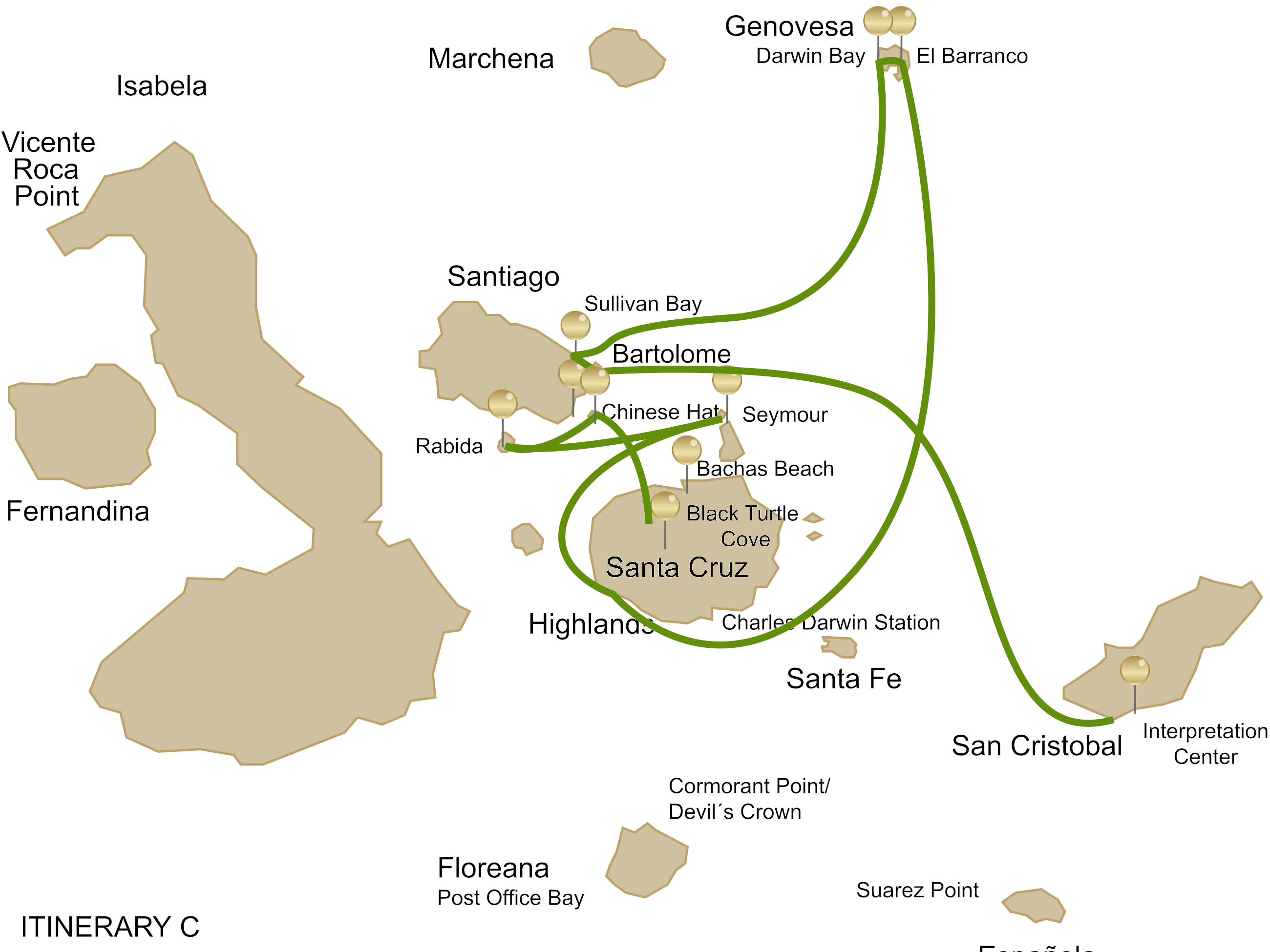
Day 1 (Thursday)
AM: Arrival, Baltra Island
Upon arrival Baltra, travellers pass through an airport inspection point to make sure that no foreign plants or animals are introduced to the islands, and to pay the park entrance fee of $200 (unless it has been prepaid). A guide will meet you, help you collect your luggage and escort you on a short bus ride to the harbour.
PM: Caleta Tortuga Negra, Santa Cruz Island
Black Turtle Cove offers engineless activities, so you will explore it by dinghy, paddling across the mangrove forested coastline of this stretch of Santa Cruz. There is great wildlife here due to the high levels of protection of this environment such as Sea Turtles, Pelicans & Sharks.
Day 2 (Friday)
AM: Sombrero Chino
Sombrero Chino, or Chinese Hat, aptly named due to its slowly sloping sides giving the island an appearance resembling that of a Chinese hat, is one of the smallest in the peninsula. The recent formation of the island gives it a unique environment where there are different stages of colonisation by pioneer species at this location compared to others you will have visited. Walking on the island is a great way to experience the island’s wildlife, including Sally Lightfoot Crabs, Marine Iguanas, Galapagos Sea Lions & Lava Lizards. Out of the cracks in dried-up lava, lava cacti are a common sight. The waters of the island are calm & home to White-Tip Reef Sharks, so there is ample opportunity for snorkelling & kayaking here too.
PM: Rábida Island
Rábida Island is unique because of the red colour of the rocks and sand. The volcanic material on this island is very porous and external factors such as rain, saltwater and sea breeze have acted as an oxidising agent. A short walk along a trail leads us to a coastal lagoon behind the beach where we can see land birds including finches, doves, yellow warblers and mockingbirds; seabirds such as pelicans, masked and blue-footed boobies; and of non-feathered species you can hope to see marine iguanas and sealions. Our team will take you to a small brackish lagoon where you can anticipate a colony of flamingos.
Day 3 (Saturday)
AM: North Seymour Island
This islet is one of most visited sites in the Galapagos and it is teeming with birdlife. An easy circular path takes you through the archipelago’s most extensive colonies of blue-footed boobies and frigate birds. At the beginning of the breeding season, adult frigatebird-males blow up their vivid red pouches (gulas) to impressive football-sized balloons. This is one of the few spots where you can compare the magnificent and the great frigatebird breeding next to each other.
You are likely to come across several land iguanas on North Seymour and the coast can be a good place to spot Galapagos sealions.
PM: Highlands, Santa Cruz Island
The road to the highlands leaves from Bellavista, a small village located a 15-minute drive from Santa Cruz’ main town of Puerto Ayora. The road passes through the Galapagos’ most productive agricultural zone, up to the National Park boundary. We find Miconia vegetation at this altitude, changing to the Fern and Sedge zone as we ascend further. With clear weather, we can enjoy beautiful scenes of rolling hills and extinct volcanic cones covered with grass and lush greenery all year round. In the Highlands is El Chato Reserve, where Giant Galapagos Tortoises can be observed in the wild – the iconic species which gave the Galapagos Islands their name. Other species to see at this reserve include Short-Eared Owls, Yellow Warblers & Finches. More elusive species which can be difficult to spot here are Galapagos Rails & Paint-Billed Crakes.
Day 4 (Sunday)
AM: El Barranco, Genovesa Island
Before landing, you will take an inflatable dinghy-ride along the eastern arm of the caldera. As we approach, the soaring 25 m / 80 ft high walls become overwhelming. Sometimes, a Galapagos fur seal is resting or a seabird is nesting on one of the ledges at the base. You will then have to hike and overcome the steep stairs from the landing dock to a bush of palo santo shrubs on top. Red-footed boobies gratefully use these scarce nesting places so that they don’t have to nest on the rocky ground. Upon arriving at the edge of the rim, the bushes open up and you can enjoy panoramic views, a sea breeze and the amazing flying skills of countless seabirds. Following the exposed rim, you will first pass a place where we usually encounter a colony of Nazca boobies; and finally reach the extensive storm petrel nesting places. If you are lucky, you can spot the well camouflaged short-eared owl hunting for them on foot!
PM: Darwin Bay, Genovesa Island
Inside the submerged caldera of Genovesa lies Darwin Bay, whose diameter is more than 1.5 km (1 mile) and it is almost 200 m (650 ft) deep. The small area will surprise you repeatedly, walking along a coral sand beach, crossing barren lava formations and creeks, passing tidal pools, shrubs and further ahead following the top of some cliffs. With this peaceful surrounding, every species has occupied its own ecological niche (or habitat) without disturbing others. There is great birdlife here with starring species including Red-Footed Boobies, Great Frigatebirds & Laval Gulls. These often share the beach with Galapagos Sea Lions.
Day 5 (Monday)
AM: Sullivan Bay, Santiago Island
Setting foot at the lava stream covering Sullivan Bay is like landing on the moon. The desolate, stretched out lava fields seem mostly lifeless, but there is plenty to see on this highly popular site, with lots to photograph. Pacific green turtles seasonally bury eggs in the tiny white sand beach, where you might also encounter crabs, a stray blue heron or an American oystercatcher. On the lava flows sparse pioneer vegetation such as lava cacti and carpetweed are able to grow. You might also encounter a lava lizard, locusts or a small species of snake called the Galapagos racer.
PM: Isla Bartolomé
One of the Galapagos’ most iconic locations, the beautiful volcanic islet of Bartolomé is among the youngest islands in the archipelago. On a geological scale Bartolomé was only recently born out of volcanic activity. Although at first sight lifeless, Bartolomé offers some of the wildest landscapes and best panoramas of the entire archipelago. To enjoy the postcard view of the idyllic Pinnacle Bay, you have to climb steps to a viewpoint on top of the island (114 m / 375 ft). Enter a dramatic world of threatening (though extinguished) nearby spatter cones, craters, and lightweight lava droplets that have been spewed out by fiery fountains. The Summit Trail is also ideal for witnessing how scanty pioneer vegetation such as lava cacti manage to take root on the bare virgin lava fields.
Day 6 (Tuesday)
AM: Interpretation Centre, San Cristobal Island
The San Cristóbal Interpretation Centre just outside the provincial capital of Puerto Baquerizo Moreno, is a perfect complement to the field explanations and briefings of your naturalist guide and host. Information panels are in English and Spanish, with many photographs, models and true to life dioramas which tell the background story of the islands in different ways. They really capture what makes the Galapagos Islands so unique. The well-maintained botanical garden with native species from the arid zone (including the giant prickly pear and candelabra cacti) is worth your visit as well; and you will probably spot the Chatham Mockingbird which is endemic to this island - a bird which put Darwin on track to his theory of evolution. The attractive exhibition is quite complete and explains a series of natural circumstances that create the Galapagos’ unique environment: such as the volcanic genesis of the islands, their remoteness from the continent, its ocean currents, its special climate, the arrival of different species, and their establishment, among others. It also recounts historic discovery and attempts of colonisation; and shows a diorama with ancient mail barrels from Post Office Bay.
PM: Departure, San Cristobal Island
Your guide and some crew members will accompany you back to San Cristobal where you will take the airport shuttle. Your guide will remain with you through check-in counters & the departure hall.
Dates
50% surcharge at Christmas & New Year.
10% discount for children (between 6 & 11 years).
Contact us for details about any further discounts which may apply, or for cabin upgrades.
*Itineraries can be Quito - Quito or Guayaquil - Guayaquil or a combination of the two cities.
Our prices exclude
International flights to/from Ecuador
Galapagos Islands airfare from/to mainland (Quito or Guayaquil)
Galapagos National Park entrance fee ($200 per person)
Transit Control Card ($20 per person)
Alcoholic & soft drinks
Tips & gratuities
Personal expenses
Travel insurance
Services not specified in itinerary
Our prices include
Airport assistance on cruise departure dates
Transportation & fuel surcharge in the Galapagos
Accommodation onboard
Naturalist guide
Meals during cruise
A snack after each activity (except on last day)
Water, coffee & tea
All cruise activities in itinerary
Airport to channel & channel to airport transport on Lobitos bus
Snorkelling gear (mask, tube, fins & wetsuit)
Kayaks & paddleboards
Shower amenities & towels
Single Supplements
For a single cabin occupancy, there is a 50% increase on the per person cabin only price (please call to check).

